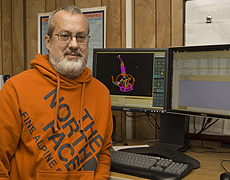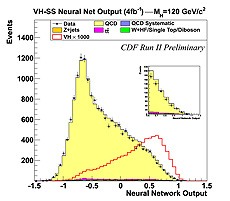Technical Division designer Gerry Davis retires this week
 |
| Gerry Davis, a designer for the Technical Division, will retire this week after 30 years at Fermilab. Displayed behind him is a computer-aided design for a component in the High Intensity Neutrino Source. |
After 30 years and three months of translating engineering specifications and technical requirements into detailed drawings and 3-D models, Technical Division designer Gerry Davis will retire this week.
Davis started work at Fermilab on Aug. 6, 1979, as a designer for Technical Support, which would later become Technical Division.
He first worked out of the basement of an old farmhouse, a location that used to be across the road from CDF, where he designed machine components by hand with drafting pencils, paper and a straightedge. He eventually moved to a trailer outside the Industrial Center Building. His design work gradually shifted toward computer-aided design.
With input from engineers and project managers, Davis manipulates a keyboard and mouse to create detailed 3-D models of every part of a machine, making decisions about how to arrange wires, pipes and other components. One of the thrills of the job, Davis said, is when after months of design work he sees the final product.
While he's enjoyed working on many projects, Davis said one of his career highlights at Fermilab was designing components for the Superconducting Super Collider.
In retirement Davis plans to move to Arizona, where he is looking forward to the warmer weather and golfing. He also plans to travel.
"I'm going to miss all of Fermilab, actually. I'll really miss the people, but I also love the work," Davis said. "I'm not going to miss the weather."
Co-worker Don Arnold, another designer in the Technical Division, said Davis has always been a valuable resource for design questions. Colleagues will miss Davis both at work and on the golf course, where Davis often played as a substitute, Arnold said.
Colleagues will gather today for coffee and cake to say farewell to Davis from 1:30 to 3:30 p.m. in Trailer 157 behind the Industrial Center Building.
— Chris Knight
|


